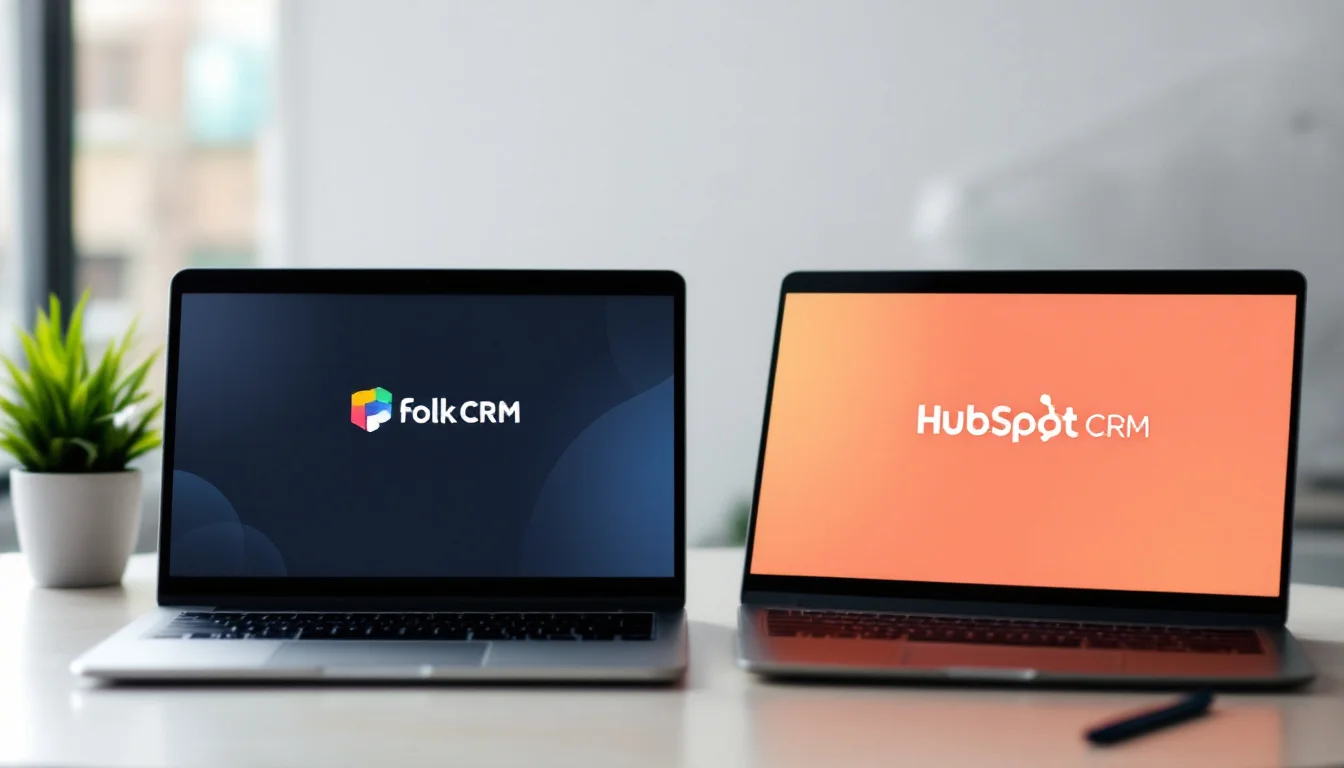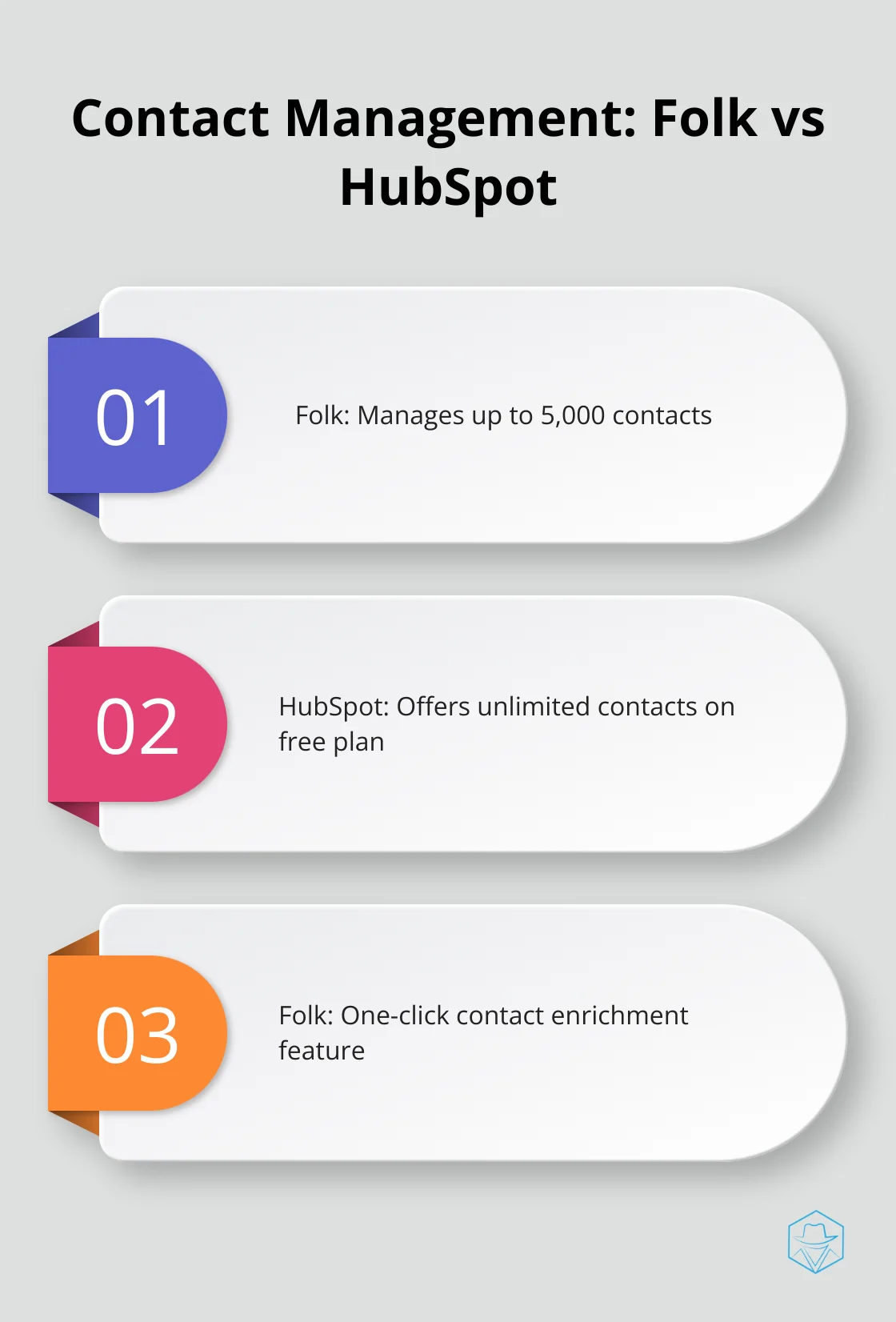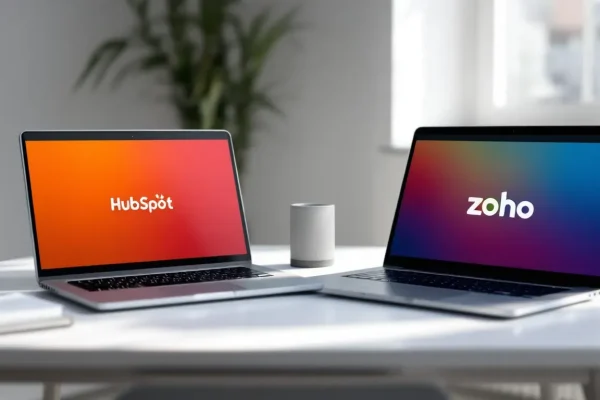Folk vs HubSpot: CRM Comparison for Small Businesses

At Drop Cowboy, we understand the importance of choosing the right CRM for small businesses. That’s why we’ve put together this comprehensive comparison of Folk vs HubSpot.
These two popular CRM platforms offer unique features and pricing structures that cater to different business needs. We’ll break down their core functionalities, pricing, and user experience to help you make an informed decision for your small business.
How Do Folk and HubSpot Compare on Core Features?
Folk and HubSpot offer distinct approaches to core CRM features. This comparison will help small businesses understand which platform aligns best with their needs.
Contact Management and Organization
Folk excels in simplicity with its spreadsheet-like interface. It allows management of up to 5,000 contacts, which suffices for most small businesses. The one-click contact enrichment feature stands out, providing quick access to detailed information without external tools.
HubSpot offers more robust contact management. It allows unlimited contacts even on its free plan (a boon for businesses with large databases). HubSpot’s contact records include comprehensive interaction histories and custom fields for tailored data collection.

Sales Pipeline and Deal Tracking
Folk provides unlimited sales pipelines, offering flexibility in organizing sales processes. This feature benefits small businesses with diverse product lines or services.
HubSpot’s pipeline management is more advanced. It offers visual deal tracking and customizable stages. Features like deal rotations and task automation can streamline sales processes for growing teams.
Email Integration and Communication
Both CRMs integrate email, but their approaches differ. Folk prioritizes simplicity with quick email synchronization for Gmail and Google Calendar. It supports bulk personalized email sending, a powerful tool for small business outreach.
HubSpot’s email integration is more comprehensive. It includes email tracking, templates, and sequences. These tools help businesses create sophisticated email marketing campaigns and track their effectiveness.
Reporting and Analytics Capabilities
HubSpot outperforms Folk in this area. It provides detailed analytics and reporting features, giving businesses actionable insights into their sales and marketing efforts. Users can create custom reports and dashboards to track KPIs and team performance.
Folk’s reporting capabilities focus on basic contact engagement metrics. While this may suffice for very small teams, businesses seeking in-depth analytics might find Folk’s offerings limited.
Mobile App Functionality
Both CRMs offer mobile apps, but HubSpot’s functionality is more extensive. It allows users to access most features on-the-go, including contact management, deal tracking, and some reporting capabilities.
Folk’s mobile app focuses on essential functions like contact access and basic pipeline management. This can adequately serve small teams that primarily work from desktops but need occasional mobile access.
As we move forward to discuss pricing and value for small businesses, it’s important to consider how these feature differences translate into cost-effectiveness for your organization.
How Much Will Folk or HubSpot Cost Your Small Business?
Folk’s Straightforward Pricing
Folk offers a simple pricing structure that starts at $20 per user per month. This flat-rate model appeals to small businesses that want predictable costs as they scale. Folk’s pricing includes most of its features, which means you won’t face unexpected charges for additional functionality.
For teams of up to 5 users, Folk’s annual plan costs $1,200 per year. This can prove cost-effective for small businesses that don’t need the extensive features of more complex CRMs.
HubSpot’s Tiered Pricing Model
HubSpot’s pricing is more complex, with various tiers and add-ons. Their free plan offers basic CRM features for unlimited users. However, as your needs grow, costs can escalate quickly.
The HubSpot Starter plan begins at $50 per month for two users, with additional users costing $25 per month each. For a team of 5, you’ll pay around $1,800 per year. This plan includes more advanced features like meeting scheduling and reporting dashboards.

The Hidden Costs of Free Plans
While HubSpot’s free plan attracts many, it’s crucial to consider the long-term implications. Many small businesses outgrow the free tier quickly, necessitating an upgrade to paid plans. This can lead to a significant jump in costs, especially if you’ve become reliant on HubSpot’s ecosystem.
Folk doesn’t offer a free plan, but its entry-level paid plan is competitively priced and includes a broader feature set from the start. This can prevent the “sticker shock” that some businesses experience when upgrading from free to paid CRM plans.
Cost-Effectiveness for Growing Teams
For small teams expecting rapid growth, HubSpot’s scalability might justify the higher costs. The platform offers extensive marketing and sales tools that can support a business as it expands. However, these advanced features come at a premium price.
Folk’s pricing remains more stable as you add users, which can benefit businesses with fluctuating team sizes or seasonal staffing needs. The platform’s focus on essential CRM features (without the bells and whistles) keeps costs manageable for small businesses.
Many small businesses struggle with CRM costs as they scale. To avoid costly platform migrations or unexpected price hikes, you should carefully project your growth and feature needs over the next 12-24 months when comparing CRM costs.
The most cost-effective CRM for your small business will depend on your specific needs, growth projections, and the value you place on advanced features versus core functionality. Both Folk and HubSpot offer unique value propositions, and the right choice will align with your business strategy and budget constraints. Now, let’s explore how these platforms stack up in terms of user experience and ease of use.
How User-Friendly Are Folk and HubSpot?
Folk and HubSpot offer distinct user experiences for small businesses adopting new CRM software. This section compares their interfaces, customization options, learning resources, and mobile accessibility.
Interface Design
Folk’s interface prioritizes simplicity with a spreadsheet-like layout. This familiar design allows small teams to start using the CRM effectively within hours. Users accustomed to Excel or Google Sheets will find Folk’s interface intuitive and easy to navigate.
HubSpot presents a more comprehensive interface. While well-organized, its numerous features can overwhelm new users. Small businesses often report needing several weeks to fully understand and utilize HubSpot’s capabilities. This learning period may impact initial productivity for teams transitioning to the platform.

Customization and Flexibility
Folk offers basic customization options focused on essential CRM functions. Users can create custom fields and adjust pipelines, but advanced customizations remain limited. This approach maintains system simplicity but may not accommodate businesses with complex, unique processes.
HubSpot excels in customization (from custom objects to workflow automation). It provides extensive options to tailor the CRM to specific business needs. However, this flexibility increases complexity. Small businesses often need to invest significant time or hire a HubSpot specialist to fully leverage these customization features.
Learning Resources and Support
Both CRMs provide customer support, but their approaches differ. Folk offers email and chat support, which typically suffices for its straightforward platform. Their support team responds quickly, often resolving issues within hours.
HubSpot’s support is more comprehensive, including a vast knowledge base, community forums, and HubSpot Academy. These resources help businesses maximize their CRM usage. However, phone support is limited to higher-tier plans (a potential frustration for some users).
Mobile Accessibility
Folk’s mobile app focuses on core functionalities like contact access and basic pipeline management. It’s designed for quick, on-the-go updates rather than comprehensive CRM management.
HubSpot’s mobile app is more feature-rich, allowing users to perform most CRM tasks from their phones. This benefits sales teams frequently out of the office. However, the app’s complexity can make it less intuitive for quick actions compared to Folk’s streamlined approach.
The choice between Folk and HubSpot depends on your business’s specific needs and technical comfort level. Folk shines in its simplicity and quick adoption, while HubSpot offers more power and customization (at the cost of a steeper learning curve).
Final Thoughts
Folk and HubSpot offer distinct advantages for small businesses. Folk excels with its user-friendly interface and straightforward pricing, making it ideal for startups and small teams who prioritize simplicity. HubSpot provides a comprehensive solution with advanced features, extensive customization options, and robust analytics (at a higher cost and learning curve).
Your choice between Folk vs HubSpot should align with your business’s current needs and future growth projections. Folk suits small teams seeking an easy-to-use CRM with core functionalities, while HubSpot fits businesses anticipating rapid expansion and requiring advanced marketing automation. We recommend evaluating your specific requirements and utilizing free trials before deciding.
For businesses aiming to enhance their marketing efforts beyond CRM capabilities, Drop Cowboy offers innovative communication solutions. Our features like ringless voicemail, SMS integration, and AI-powered voice cloning can complement your CRM strategy. The right CRM should improve efficiency and drive growth for your small business.
blog-dropcowboy-com
Related posts

April 25, 2025
HubSpot vs Constant Contact: Email Marketing Face-Off
Compare HubSpot vs Constant Contact to find the best email marketing tool. Evaluate features, pricing, and benefits for effective campaigns.

June 16, 2025
Easy Ways to Expand Your Outreach with Targeted Telemarketing Services
Struggling to get your message in front of the right people? Many businesses face this challenge as digital noise makes it harder to stand out. One proven method that still delivers results is using telemarketing services to build direct connections with potential clients. These services allow for real-time interaction, helping companies reach targeted leads with greater impact. […]

August 11, 2025
Slybroadcast api
Explore Slybroadcast API capabilities for seamless business communication. Learn how it enhances efficiency and connects effortlessly with audiences.

July 1, 2025
Batch Dialer Pricing: Find the Best Value for You
Explore batch dialer pricing and uncover the best value options. Save money while maximizing efficiency with our detailed analysis and practical tips.

March 26, 2025
HubSpot or Zoho: Choosing the Best CRM Platform
Compare HubSpot vs Zoho to find the best CRM platform for your business needs. Explore features, pricing, and user reviews in our detailed analysis.

June 10, 2025
GoHighLevel CRM: All-in-One Marketing Platform
Explore GoHighLevel CRM for seamless marketing integration, enhancing business efficiency and customer management with an all-in-one powerful platform.